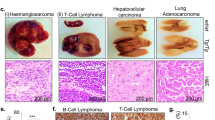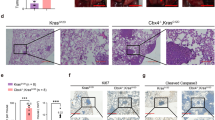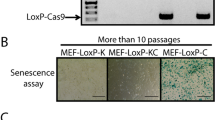Abstract
Krüppel-like factor 4 (KLF4) is a zinc-finger transcription factor with tumor suppressive activity in colorectal cancer. Here, we investigated whether KLF4 is involved in maintaining genetic stability in mouse embryonic fibroblasts (MEFs) isolated from mice wild type (+/+), heterozygous (+/−), or homozygous (−/−) for the Klf4 alleles. Compared to Klf4+/+ and Klf4+/− MEFs, Klf4−/− MEFs had both a higher level of apoptosis and rate of proliferation. Quantification of chromosome numbers showed that Klf4−/− MEFs were aneuploid. A higher number of Klf4−/− MEFs exhibited γ-H2AX foci and had higher amounts of γ-H2AX compared to controls. Cytogenetic analysis demonstrated the presence of numerous chromosome aberrations including dicentric chromosomes, chromatid breaks, and double minute chromosomes in Klf4−/− cells but in few, if any, Klf4+/+ or Klf4+/− MEFs. Approximately 25% of Klf4−/− MEFs exhibited centrosome amplification in contrast to the less than 5% of Klf4+/+ or Klf4+/− MEFs. Finally, only Klf4−/− MEFs were capable of anchorage-independent growth. Taken together, these findings demonstrate that MEFs null for the Klf4 alleles are genetically unstable, as evidenced by the presence of aneuploidy, chromosome aberration and centrosome amplification. The results support a crucial role for KLF4 in maintaining genetic stability and as a tumor suppressor.
This is a preview of subscription content, access via your institution
Access options
Subscribe to this journal
Receive 50 print issues and online access
$259.00 per year
only $5.18 per issue
Buy this article
- Purchase on Springer Link
- Instant access to full article PDF
Prices may be subject to local taxes which are calculated during checkout






Similar content being viewed by others
Abbreviations
- BrdU:
-
bromodeoxyuridine
- BSA:
-
bovine serum albumin
- CIN:
-
chromosomal instability
- DMEM:
-
Dulbecco's modified Eagle's medium
- FBS:
-
fetal bovine serum
- KLF4:
-
Krüppel-like factor 4
- MEFs:
-
mouse embryo fibroblasts
- PBS:
-
phosphate-buffered saline
References
Bartkova J, Rezaei N, Liontos M, Karakaidos P, Kletsas D, Issaeva N et al. (2006). Oncogene-induced senescence is part of the tumorigenesis barrier imposed by DNA damage checkpoints. Nature 444: 633–637.
Bieker JJ . (2001). Kruppel-like factors: three fingers in many pies. J Biol Chem 276: 34355–34358.
Black AR, Black JD, Azizkhan-Clifford J . (2001). Sp1 and Kruppel-like factor family of transcription factors in cell growth regulation and cancer. J Cell Physiol 188: 143–160.
Chen X, Johns DC, Geiman DE, Marban E, Dang DT, Hamlin G et al. (2001). Kruppel-like factor 4 (gut-enriched Kruppel-like factor) inhibits cell proliferation by blocking G1/S progression of the cell cycle. J Biol Chem 276: 30423–30428.
Chen X, Whitney EM, Gao SY, Yang VW . (2003). Transcriptional profiling of Kruppel-like factor 4 reveals a function in cell cycle regulation and epithelial differentiation. J Mol Biol 326: 665–677.
Chng WJ, Braggio E, Mulligan G, Bryant B, Remstein E, Valdez R et al. (2008). The centrosome index is a powerful prognostic marker in myeloma and identifies a cohort of patients that might benefit from aurora kinase inhibition. Blood 111: 1603–1609.
D’Assoro AB, Lingle WL, Salisbury JL . (2002). Centrosome amplification and the development of cancer. Oncogene 21: 6146–6153.
Dalton WB, Nandan MO, Moore RT, Yang VW . (2007). Human cancer cells commonly acquire DNA damage during mitotic arrest. Cancer Res 67: 11487–11492.
Dang DT, Bachman KE, Mahatan CS, Dang LH, Giardiello FM, Yang VW . (2000a). Decreased expression of the gut-enriched Kruppel-like factor gene in intestinal adenomas of multiple intestinal neoplasia mice and in colonic adenomas of familial adenomatous polyposis patients. FEBS Lett 476: 203–207.
Dang DT, Pevsner J, Yang VW . (2000b). The biology of the mammalian Kruppel-like family of transcription factors. Int J Biochem Cell Biol 32: 1103–1121.
Fukasawa K, Choi T, Kuriyama R, Rulong S, Vande Woude GF . (1996). Abnormal centrosome amplification in the absence of p53. Science 271: 1744–1747.
Fukasawa K, Wiener F, Vande Woude GF, Mai S . (1997). Genomic instability and apoptosis are frequent in p53 deficient young mice. Oncogene 15: 1295–1302.
Fukasawa K . (2005). Centrosome amplification, chromosome instability and cancer development. Cancer Lett 230: 6–19.
Fukasawa K . (2007). Oncogenes and tumour suppressors take on centrosomes. Nat Rev Cancer 7: 911–924.
Ganem NJ, Storchova Z, Pellman D . (2007). Tetraploidy, aneuploidy and cancer. Curr Opin Genet Dev 17: 157–162.
Garrett-Sinha LA, Eberspaecher H, Seldin MF, de Crombrugghe B . (1996). A gene for a novel zinc-finger protein expressed in differentiated epithelial cells and transiently in certain mesenchymal cells. J Biol Chem 271: 31384–31390.
Gartel AL, Tyner AL . (2002). The role of the cyclin-dependent kinase inhibitor p21 in apoptosis. Mol Cancer Ther 1: 639–649.
Ghadimi BM, Sackett DL, Difilippantonio MJ, Schrock E, Neumann T, Jauho A et al. (2000). Centrosome amplification and instability occurs exclusively in aneuploid, but not in diploid colorectal cancer cell lines, and correlates with numerical chromosomal aberrations. Genes Chromosomes Cancer 27: 183–190.
Ghaleb AM, Katz JP, Kaestner KH, Du JX, Yang VW . (2007a). Kruppel-like factor 4 exhibits antiapoptotic activity following gamma-radiation-induced DNA damage. Oncogene 26: 2365–2373.
Ghaleb AM, McConnell BB, Nandan MO, Katz JP, Kaestner KH, Yang VW . (2007b). Haploinsufficiency of Kruppel-like factor 4 promotes adenomatous polyposis coli dependent intestinal tumorigenesis. Cancer Res 67: 7147–7154.
Ghaleb AM, Nandan MO, Chanchevalap S, Dalton WB, Hisamuddin IM, Yang VW . (2005). Kruppel-like factors 4 and 5: the yin and yang regulators of cellular proliferation. Cell Res 15: 92–96.
Ghaleb AM, Yang VW . (2008). The pathobiology of Kruppel-like factors in colorectal cancer. Curr Colorectal Cancer Rep 4: 59–64.
Hanashiro K, Kanai M, Geng Y, Sicinski P, Fukasawa K . (2008). Roles of cyclins A and E in induction of centrosome amplification in p53-compromised cells. Oncogene 27: 5288–5302.
Harvey M, Sands AT, Weiss RS, Hegi ME, Wiseman RW, Pantazis P et al. (1993). In vitro growth characteristics of embryo fibroblasts isolated from p53-deficient mice. Oncogene 8: 2457–2467.
Hinchcliffe EH, Sluder G . (2002). Two for two: Cdk2 and its role in centrosome doubling. Oncogene 21: 6154–6160.
Kaczynski J, Cook T, Urrutia R . (2003). Sp1- and Kruppel-like transcription factors. Genome Biol 4: 206.
Kanai M, Wei D, Li Q, Jia Z, Ajani J, Le X et al. (2006). Loss of Kruppel-like factor 4 expression contributes to Sp1 overexpression and human gastric cancer development and progression. Clin Cancer Res 12: 6395–6402.
Katz JP, Perreault N, Goldstein BG, Actman L, McNally SR, Silberg DG et al. (2005). Loss of Klf4 in mice causes altered proliferation and differentiation and precancerous changes in the adult stomach. Gastroenterology 128: 935–945.
Katz JP, Perreault N, Goldstein BG, Lee CS, Labosky PA, Yang VW et al. (2002). The zinc-finger transcription factor Klf4 is required for terminal differentiation of goblet cells in the colon. Development 129: 2619–2628.
Kawamura K, Izumi H, Ma Z, Ikeda R, Moriyama M, Tanaka T et al. (2004). Induction of centrosome amplification and chromosome instability in human bladder cancer cells by p53 mutation and cyclin E overexpression. Cancer Res 64: 4800–4809.
Kirschner M, Mitchison T . (1986a). Beyond self-assembly: from microtubules to morphogenesis. Cell 45: 329–342.
Kirschner MW, Mitchison T . (1986b). Microtubule dynamics. Nature 324: 621.
Lee JM, Abrahamson JL, Kandel R, Donehower LA, Bernstein A . (1994). Susceptibility to radiation-carcinogenesis and accumulation of chromosomal breakage in p53 deficient mice. Oncogene 9: 3731–3736.
Lee JJ, Warburton D, Robertson EJ . (1990). Cytogenetic methods for the mouse: Preparation of chromosomes, karyotyping, and in situ hybridization. Anal Biochem 189: 1–17.
Lengauer C, Kinzler KW, Vogelstein B . (1998). Genetic instabilities in human cancers. Nature 396: 643–649.
Lingle WL, Barrett SL, Negron VC, D’Assoro AB, Boeneman K, Liu W et al. (2002). Centrosome amplification drives chromosomal instability in breast tumor development. Proc Natl Acad Sci USA 99: 1978–1983.
Lingle WL, Salisbury JL . (1999). Altered centrosome structure is associated with abnormal mitoses in human breast tumors. Am J Pathol 155: 1941–1951.
Mayer F, Stoop H, Sen S, Bokemeyer C, Oosterhuis JW, Looijenga LH . (2003). Aneuploidy of human testicular germ cell tumors is associated with amplification of centrosomes. Oncogene 22: 3859–3866.
McConnell BB, Ghaleb AM, Nandan MO, Yang VW . (2007). The diverse functions of Kruppel-like factors 4 and 5 in epithelial biology and pathobiology. Bioessays 29: 549–557.
Rajagopalan H, Lengauer C . (2004). Aneuploidy and cancer. Nature 432: 338–341.
Rogakou EP, Pilch DR, Orr AH, Ivanova VS, Bonner WM . (1998). DNA double-stranded breaks induce histone H2AX phosphorylation on serine 139. J Biol Chem 273: 5858–5868.
Rowland BD, Bernards R, Peeper DS . (2005). The KLF4 tumour suppressor is a transcriptional repressor of p53 that acts as a context-dependent oncogene. Nat Cell Biol 7: 1074–1082.
Rowland BD, Peeper DS . (2006). KLF4, p21 and context-dependent opposing forces in cancer. Nat Rev Cancer 6: 11–23.
Salisbury JL, D’Assoro AB, Lingle WL . (2004). Centrosome amplification and the origin of chromosomal instability in breast cancer. J Mammary Gland Biol Neoplasia 9: 275–283.
Segre JA, Bauer C, Fuchs E . (1999). Klf4 is a transcription factor required for establishing the barrier function of the skin. Nat Genet 22: 356–360.
Shields JM, Christy RJ, Yang VW . (1996). Identification and characterization of a gene encoding a gut-enriched Kruppel-like factor expressed during growth arrest. J Biol Chem 271: 20009–20017.
Sotillo R, Hernando E, Diaz-Rodriguez E, Teruya-Feldstein J, Cordon-Cardo C, Lowe SW et al. (2007). Mad2 overexpression promotes aneuploidy and tumorigenesis in mice. Cancer Cell 11: 9–23.
Spruck CH, Won KA, Reed SI . (1999). Deregulated cyclin E induces chromosome instability. Nature 401: 297–300.
Takada Y, Ichikawa H, Pataer A, Swisher S, Aggarwal BB . (2007). Genetic deletion of PKR abrogates TNF-induced activation of IkappaBalpha kinase, JNK, Akt and cell proliferation but potentiates p44/p42 MAPK and p38 MAPK activation. Oncogene 26: 1201–1212.
Tarapore P, Fukasawa K . (2002). Loss of p53 and centrosome hyperamplification. Oncogene 21: 6234–6240.
Tarapore P, Horn HF, Tokuyama Y, Fukasawa K . (2001). Direct regulation of the centrosome duplication cycle by the p53-p21Waf1/Cip1 pathway. Oncogene 20: 3173–3184.
Tarapore P, Okuda M, Fukasawa K . (2002). A mammalian in vitro centriole duplication system: evidence for involvement of CDK2/cyclin E and nucleophosmin/B23 in centrosome duplication. Cell Cycle 1: 75–81.
Todaro GJ, Green H . (1963). Quantitative studies of the growth of mouse embryo cells in culture and their development into established lines. J Cell Biol 17: 299–313.
Tokuyama Y, Horn HF, Kawamura K, Tarapore P, Fukasawa K . (2001). Specific phosphorylation of nucleophosmin on Thr(199) by cyclin-dependent kinase 2-cyclin E and its role in centrosome duplication. J Biol Chem 276: 21529–21537.
Weaver BA, Cleveland DW . (2006). Does aneuploidy cause cancer? Curr Opin Cell Biol 18: 658–667.
Weaver BA, Cleveland DW . (2007). Aneuploidy: instigator and inhibitor of tumorigenesis. Cancer Res 67: 10103–10105.
Wei D, Gong W, Kanai M, Schlunk C, Wang L, Yao JC et al. (2005). Drastic down-regulation of Kruppel-like factor 4 expression is critical in human gastric cancer development and progression. Cancer Res 65: 2746–2754.
Yoon HS, Chen X, Yang VW . (2003). Kruppel-like factor 4 mediates p53-dependent G1/S cell cycle arrest in response to DNA damage. J Biol Chem 278: 2101–2105.
Yoon HS, Ghaleb AM, Nandan MO, Hisamuddin IM, Dalton WB, Yang VW . (2005). Kruppel-like factor 4 prevents centrosome amplification following gamma-irradiation-induced DNA damage. Oncogene 24: 4017–4025.
Yoon HS, Yang VW . (2004). Requirement of Kruppel-like factor 4 in preventing entry into mitosis following DNA damage. J Biol Chem 279: 5035–5041.
Zhang W, Geiman DE, Shields JM, Dang DT, Mahatan CS, Kaestner KH et al. (2000). The gut-enriched Kruppel-like factor (Kruppel-like factor 4) mediates the transactivating effect of p53 on the p21WAF1/Cip1 promoter. J Biol Chem 275: 18391–18398.
Zhao W, Hisamuddin IM, Nandan MO, Babbin BA, Lamb NE, Yang VW . (2004). Identification of Kruppel-like factor 4 as a potential tumor suppressor gene in colorectal cancer. Oncogene 23: 395–402.
Acknowledgements
We thank Dr Klaus Kaestner and Dr Jonathan Katz for providing the Klf4+/− mice. This work was in part supported by grants from the National Institutes of Health (DK52230, DK64399, and CA84197). EGH was an Emory Fellowships in Research and Science Teaching (FIRST) fellow. AMG was the recipient of a NIH National Research Service Award (CA130308). WBD was supported in part by an Emory Biochemistry, Cell and Developmental Biology (BCDB) training grant.
Author information
Authors and Affiliations
Corresponding author
Additional information
Supplementary Information accompanies the paper on the Oncogene website (http://www.nature.com/onc)
Supplementary information
Rights and permissions
About this article
Cite this article
Hagos, E., Ghaleb, A., Dalton, W. et al. Mouse embryonic fibroblasts null for the Krüppel-like factor 4 gene are genetically unstable. Oncogene 28, 1197–1205 (2009). https://doi.org/10.1038/onc.2008.465
Received:
Revised:
Accepted:
Published:
Issue Date:
DOI: https://doi.org/10.1038/onc.2008.465
Keywords
This article is cited by
-
Loss of fragile WWOX gene leads to senescence escape and genome instability
Cellular and Molecular Life Sciences (2023)
-
A distinct epigenetic program underlies the 1;7 translocation in myelodysplastic syndromes
Leukemia (2019)
-
Impaired autophagy in mouse embryonic fibroblasts null for Krüppel-like Factor 4 promotes DNA damage and increases apoptosis upon serum starvation
Molecular Cancer (2015)
-
Krüppel-like factor 4 regulates genetic stability in mouse embryonic fibroblasts
Molecular Cancer (2013)
-
Endogenous mammalian histone H3.3 exhibits chromatin-related functions during development
Epigenetics & Chromatin (2013)



